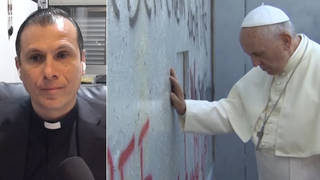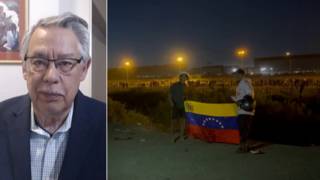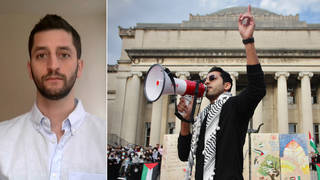
Guests
- Rachel Nolanhistorian of modern Latin America at the Pardee School of Global Studies at Boston University. Her new report for The New Yorker magazine is titled “A Translation Crisis at the Border.”
- Odilia RomeroZapotec interpreter and an indigenous leader with the Binational Front of Indigenous Organizations for over 25 years. Romero is a trilingual interpreter in Zapotec, Spanish and English, who recently developed a training program for indigenous-language interpreters.
As the U.S. continues to use hostile policies to stop people from seeking refuge and asylum in the United States, we look at a key problem that is preventing migrants from getting due process, and in many cases getting them deported: inadequate interpretation for indigenous asylum seekers who speak Mayan languages. Guatemala has a population of 15 million people, and at least 40% of them are indigenous. In the past year, a quarter of a million Guatemalan migrants have been apprehended at the U.S.-Mexico border. At least half of them are Mayan. Many speak little or no Spanish. This is the focus of a new report in The New Yorker magazine titled “A Translation Crisis at the Border.” We speak with the article’s author, Rachel Nolan, in Guatemala City. We also spoke with Odilia Romero, Zapotec interpreter and a longtime indigenous leader with the Binational Front of Indigenous Organizations. Romero is a trilingual interpreter in Zapotec, Spanish and English, who recently developed a training program for indigenous-language interpreters.
Transcript
AMY GOODMAN: This is Democracy Now! I’m Amy Goodman. As the U.S. continues to use hostile policies to stop people from seeking refuge and asylum in the United States, we look at a key problem that’s preventing migrants from getting due process, and in many cases getting them deported: inadequate translation for indigenous asylum seekers who speak Mayan languages.
Guatemala has a population of 15 million people. At least 40% of them are indigenous. In the past year, a quarter of a million Guatemalan migrants have been apprehended at the U.S.-Mexico border. At least half of them are Mayan. Many speak little or no Spanish.
That’s the focus of a New Yorker magazine article headlined “A Translation Crisis at the Border.” I had a chance to interview the author of that article, Rachel Nolan, at Constitutional Plaza in Guatemala City. She is an assistant professor of international relations at Boston University. And we spoke to Odilia Romero, Zapotec interpreter, indigenous leader with the Binational Front of Indigenous Organizations for 25 years. I started by asking Rachel Nolan to lay out her piece.
RACHEL NOLAN: Well, thank you so much for having me, Amy. In the course of reporting the story for The New Yorker, I found that many migrants who reach the U.S.-Mexico border are not given access to Mayan-language translation at all. In fact, during credible-fear interviews, during which migrants have to lay out why they’re afraid of returning to their country of origin, many Mayan-language speakers from Guatemala are forced to do so in Spanish, which is a language that they do not speak.
So I’ve heard cases of people being deported after signing papers that they don’t understand. I’ve heard cases of families being separated and children isolated, spoken to in Spanish, which is a language that they don’t understand. And many Mayan-language speakers who are attempting to gain asylum, I’ll say — they’re not migrating into the United States seeking work; they’re attempting to access asylum — and they’re only often given access to Mayan-language translation at their final court date, if at all.
AMY GOODMAN: Can you tell us a story, one of the people profile? This also goes to the horrific issue of the separation of parents and their children, how you begin your piece.
RACHEL NOLAN: I wanted to focus this story not just on the Mayan-language speakers who have been the victims of some of these immigration policies, but also on those Mayan-language speakers who are doing their best to help. There’s a large community, of which Odilia is a part — and it’s an honor to have her on the program with me — mostly based in California, although throughout the United States, that are providing Mayan-language translation to immigrants crossing the U.S. border.
And one of those people that I was able to speak with at great length and profile and follow is Oswaldo Vidal Martín, who is a Mam-language speaker. Mam is one of 22 mutually unintelligible Mayan languages. And Oswaldo is based in Fruitvale, which is in the kind of Oakland area of California. And Oswaldo was actually called to the border about a year ago, during the family separation crisis, and asked to interpret for several lawyers at the Texas Civil Rights Project. And he and many other Mayan-language translators went, in both paid and volunteer capacity, to the border.
And one of the families that he encountered was that of Mario Perez Domingo, who was a Mam-language speaker separated from his 2-year-old girl at the border because the Border Patrol had asked — had asked him whether he had paid for a birth certificate for his 2-year-old daughter with whom he was traveling. Now, Mario does not speak Spanish very well. Like many Mayan-language speakers in Guatemala, he speaks enough to go to the store, maybe sell tomatoes in the market, but not to navigate a complex legal interview. And so, like many indigenous-language speakers at the border, he was afraid and was answering yes to many of the questions that he was asked.
And so, in Guatemala, you do pay a very small fee to get a birth certificate. So when he was asked had he paid for the birth certificate of his daughter, he answered yes. And the Border Patrol agent used that answer as supposed evidence that he had paid for a false birth certificate, which was not true. And on the basis of that, he was separated from his daughter for several months. And because Mario only speaks Mam, he was not able to understand what was happening and why his daughter was separated from him. Again, Mam is his primary language, and he speaks very little Spanish, if at all. So he was answering yes, yes, yes, to try to ingratiate himself to the authorities, to try to control was what was clearly a very fearful situation.
And only once Oswaldo, the Mam-language translator from California, arrived on the scene in Texas was Mario’s lawyer able to get all of the details of the case and work toward reuniting Mario Perez Domingo with his daughter, which eventually happened, but they were separated for a number of months because of language issues.
AMY GOODMAN: I wanted to bring Odilia Romero into this conversation. If you could explain what the crisis you confronted was, what you saw, and how you saw, with this massive crackdown on migrants along the border, that the lack of interpretation was leading so many people to be either deported or separated from their children, and then what you did about it?
ODILIA ROMERO: Well, our experience at the Binational Front of Indigenous Organizations — for short, I will call it FIOB — was, suddenly we started getting calls. And a little bit I wanted to tell you the history of interpreting in California for indigenous people started in 1996 and ’97 by the FIOB training Mayans and Mexican indigenous interpreters. So people knew of our existence.
Suddenly, we just started getting these calls. We have: “We need K’iche’. We need Zapotec. We need Mam.” And suddenly everybody’s calling us. We were getting calls from social media, texts. And at that point, you know, we didn’t know what to do, because there were so many. And the agencies will call us and say, “I need Zapoteco.” And I will get on the phone, because they wouldn’t know what kind of — what variant of Zapotec. So I will get on the phone; it turned out to be Chinanteco. They were just getting those calls to us and trying — figuring how to solve a problem, right?
So, some of the things that we went — we went to Texas, actually, and we went to some of the detention centers. And we found out people weren’t getting an interpreter. People didn’t know how to identify the languages. So we launched a campaign, one training more interpreters throughout the U.S. So we’ve been training interpreters in Chicago, in D.C. We’re going to New York this month. In California, everywhere that we can, where these different variants of languages existed. That way, we are able to respond to some of the needs that we’re having at the border and we’re going to continue having at the border.
AMY GOODMAN: I wanted to go to this issue of the for-profit, over-the-phone translations that take place and how it jeopardizes the legitimate asylum claims of so many indigenous people. If you could lay this out for us and then talk about the philosophy behind your translation, interpretation service?
ODILIA ROMERO: I took the test with one of the companies. And as an ethical interpreter, I know I did not pass the test. But when they came back with the result, they said, “Excellent, you’re ready to go interpret in immigration court in Zapotec.” And I asked, “Well, how did you check? Like, how do you know that I was interpreting adequately?” And they told me, “We have a methodology, so you’re good to go.” So then we had our other trilingual interpreters take the test. And they all, being ethical and being trained by us, were like, “We did not pass this test. We are not going to go do it.” So, they do not care there.
And one of the things for us is the way that interpreting was developed was by Spanish-English interpreters. And nobody thought about us on how to develop a manual, on a code of ethics. Nothing was thought within us when these interpretation rules were developed.
And, you know, some of the things for us as an indigenous interpreter, we were seeing, well, these aren’t making sense to us. We cannot interpret word per word. In the case of asylum, in my language, I will have — I will have to say that you can — you have to leave, because you could no longer be here because you’re afraid that someone within this community or within this pueblo is going to hurt you, right? And if I say “refugee,” I’m afraid for my life that someone’s going to kill me. So they’re two different things. So, if our interpreters do not know the difference between asylum and between refugee, they will not be able to convey the message. So we have to — so we have to train them what are these words, because a lot of these pro-profit language agencies, all the interpreters that they have, they borrow Spanish — reshnabo [phon.], asilo, reshnabo [phon.], or refugio. That’s not being said anything to that individual or to that detainee, as opposed to, you know, [speaking Zapotec], which is a very different thing than just reshnabo [phon.], asilo.
So, that’s at the level we’ve gone in our language program to talk about how do we think about these words. How do we think from the immigration language, to the court language, to the medical language? How do we put it into our words? How do we describe it, right? Because it is asilo, asylum. It’s very easy to just translate from Spanish, interpret from Spanish to English. However, for us, it’s very descriptive, so we have to train our interpreters.
But the for-profit language agencies, it’s not about the human rights of the detainees. It’s about making money, who gets the bid. I’ve gotten calls from these companies: “Can you just take the calls?” “I can’t, because I don’t know what variant of Zapotec it is.” “Just take the call. Zapotec is Zapotec.”
So, what we’re doing is training from a very different point as the standard models that they exist in the Spanish-language, Spanish-interpreting schools. We had to develop our own curricula. We had to develop our own glossary. We had to develop everything for ourselves as indigenous people. So it’s a lot of work.
But I think it’s so important that we’re trained, because the life of a person depends on us as the interpreters. If I go to a hospital and I’m not instructed how to give my child a medicine in my language, I might put him at risk. If I go to the court and I don’t know how to say “asylum” and I don’t understand the court system, I could be that tool to deport the person.
AMY GOODMAN: So you have to understand as much Western culture and what’s happening here in the United States as you do indigenous culture.
ODILIA ROMERO: Yes, you have to understand the Western culture very well and then be able to convert it to an indigenous world, in the same way an indigenous worldview to the Western world.
I will tell you about a case about a man that his child was taken away. And he told me in Zapotec, “When they took my children away, the tears just fell out of my eyes and my face like the rain in August in our region.” If I interpret that literally, it doesn’t make any sense to Western world, right? But these are the way, in the case of Zapoteco, is how he told me. “And when I finally was on the bus, the tears just popped out, like the hail after the rain.” And that doesn’t make any sense, because the sentences are not very clear. So I need to be able to convert that into the Western world. And this man, when his child was taken away, I mean, he didn’t know. He agreed to meet these — this was at the Department of Social Services. He went there because they had called the police on him, because the child wasn’t growing. And when they got there, they just like, “OK, sign these papers.” The kids were taken away, and he didn’t know what happened.
And so, we need to know both worlds, like what do the Department of Social Services do, what is the immigration languages, what is the vocabulary. Otherwise, we’re not being useful to indigenous people as interpreters. And we really have to be ethical about it and be honest if I don’t know the word.
But then there’s the other issue that we have, is our biggest ally or our biggest enemy will be the Spanish-English interpreter. If they notice that we’re not making coherent sentences, they should stop us and ask, “Are you understanding what asylum is? Can I explain it to you?” as opposed to just continuing. And I mention the Spanish-English interpreters because there are very few trilingual interpreters in the U.S. Most of them are bilingual, so they have to work with a relay interpreter, which is a Spanish-English interpreter, and that makes it much more difficult. And if that Spanish and English interpreter just continues to interpret it without questioning, if they’re seeing that we’re borrowing a lot of Spanish words, they should stop us. And this is who you have to work with. So, instead of saying, “This interpreter is not doing their interpreting adequately,” stop and say, “How can I help you? Like, how can I explain asylum for you? Do you know where, you know, the calendar is in immigration court?” So, we have a lot of challenges, so we’re trying to solve them little by little.
AMY GOODMAN: As you stand there in Guatemala City, Rachel Nolan, if you could talk about what most surprised you as you did this piece for The New Yorker, as you did your research, “A Translation Crisis at the Border,” and what you feel, what are people saying, needs to happen now?
RACHEL NOLAN: I was shocked at the extent of the problem, frankly. When I called Lee Gelernt of the ACLU and asked him, you know, “To what extent are the issues that are affecting all Central American asylum seekers in the United States affecting indigenous-language speakers?” he said, “It’s enormous. They’re disproportionately affected. All of the problems that Spanish-language asylum seekers face are exacerbated if they speak Mayan languages.”
So, just to give one example, when we were speaking on the phone, Lee Gelernt of the ACLU told me that of the kind of worst cases of families that were separated at the border under Trump’s “zero tolerance” policy — and I will remind everyone that that policy is officially over, but the separations are ongoing. At least 900 families have been separated since the official end of that policy over a year ago. But Lee Gelernt of the ACLU told me that of those over 4,000 families that were separated — and one parent, at least, was deported back to their country of origin without their child — of those 4,000 cases, Lee Gelernt of the ACLU estimated that 10 to 20% affected Mayan-language-speaking Guatemalans. That’s an enormous — that’s not just of the Guatemalan asylum seekers. That’s of all of the families separated. So, the kind of scale of the problem was what most surprised me when I began reporting this story.
AMY GOODMAN: Rachel Nolan’s piece in The New Yorker is “A Translation Crisis at the Border.” We’ll link to it at democracynow.org. Odilia Romero is a Zapotec interpreter with the Binational Front of Indigenous Organizations.
For the full conversation, go to democracynow.org. Monday: Dr. Martin Luther King special.













Media Options